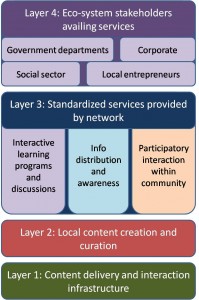Download our whitepaper on sustainable rural information service networks. Excerpts are below.
Information services in rural areas
The role that the Internet has played in building awareness through information access and building collaboration through interactive info services cannot be denied. But the Internet has made one other fundamental contribution. Even though Internet access is available currently to only 150M Indians, projected to increase to 300M by 2017, leaving just as large a population without access to the Internet, the Internet has demonstrated the NEED for universal information services, irrespective of the nature of the infrastructure.
The Internet has shown how interactive information services can be useful to make people aware, allow self expression, allow participation in governance discourse, and use info services to supplement existing economic activities while also creating new markets.
So how can an information eco-system be developed with or without the Internet, which can do the following:
- Provide a means of information dissemination which is sensitive to the local context to help make people understand the information more easily
- Provide an interactive environment to allow communities to discuss and debate, and consequently help each other understand and arrive at consensus on issues of relevance
- Provide an environment to build custom information services which can supplement local economic activities and even enable new markets such as those created on the Internet
- Enable all of the above in a financially sustainable manner, using appropriate technologies, at low costs, in ways that can interleave seamlessly with the local context and capabilities of people

We consider 4 essential layers, bottom up:
- Layer 1: Technology infrastructure capable of building interactive information services
- Layer 2: Local content creation and curation, to ensure contextual relevance
- Layer 3: Methods to ensure standardization of services to guarantee clean interfaces for third parties to use the information services
- Layer 4: An eco-system of stakeholders concerned with providing information and info services
The rest of this whitepaper aims to unpack these layers and demonstrate how this eco-system can be enabled sustainably.
Financial models for sustainability of information networks
We postulate two ways of jointly building financial sustainability for the model:
Local revenue generation by content creation and curation organizations: Entities such as community radio stations already get revenues from local advertisers and classifieds, which is not sufficient for them to break even, but does help cover up to 20% of their operational costs. Some networks are also partly supported through micro-donations from the community, but these are rare exceptions.
Channeling of third party funding: Government departments, development agencies, and corporate organizations are keen to sponsor interactive learning programs, information dissemination, and community participation in governance decision making. The current gap lies in assuring SLAs on outreach, quality of programming, measurable return on investment, and coverage in desired geographies.




